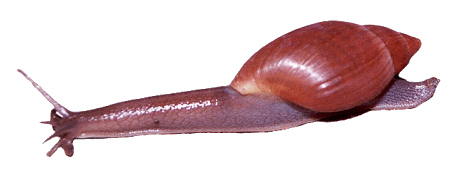|
The
World’s Departments of Agriculture
WANTED SNAIL! This species has been nominated as among 100 of the "World's Worst" invaders |
||
|
Rosy
Wolf Snail I
have found NO Evidence of a pet trade existing with this snail due to
the nature of the beast - "it predates other snails". AB |
||
|
Names:
Aliases:
|
||
|
General Description:
The adult rosy wolf snail has a thick shell with prominent growth lines. The shell is tall and slender , height up to about 6 - 7.5 cm (2 - 3 inches) with a width to about 2 cm. (under 1 inch). It's a pretty rosy - pink in color and almost translucent. The immature snails have a shorter, squater shell and can be almost appear yellowish in color. Their soft body is a pinkish gray in color and is long and slender. The head is most interesting and It almost looks like the wolf snail had six instead of four tentacles. This "extra" pair of appendages are actually elongated lips with which the snail follows its prey around using chemical receptors in these lips to follow the slime trail of prey snails. |
||
|
Sex: Euglandina
rosea is a cross-fertilizing hermaphroditic
(both male and female) species which lay approximately 25 - 40 eggs
a year |
||
|
Life Span:
|
||
|
Eating Habits:
The favorite prey of the Rosy Wolf Snail are other small terrestrial snails. It locates them by using their prolonged lips which contain chemical receptors used to pick up the scent of prey through their slime trails. They can pursue their prey with an average speed 2 to 3 times higher than that of most other snails. When they catch up with their prey, the wolf snail will eat tiny snails as whole, while it will eat the larger snails through their apertures (Shell opening ). With their long,slender bodies, they can reach well into the innermost parts of a prey's shell.
The Rosy Wolf Snail will even crawl up trees to find snails and can even travel short distances under water in search of their prey. When these snails have been introduced to foreign habitats to control other problem snails, they have been the cause of the loss of endemic tree and other terrestrial snails.
Euglandina also eat slugs. Smaller slugs are swallowed whole, larger slugs are consumed in pieces. Once the wolf snail catches a slug, there is usually there is no escape for it.
Euglandina are also cannibalistic. They will not hesitate to attack other wolf snails. Young wolf snails, freshly hatched, will at once crawl around and go after prey. They will often eat their smaller siblings (brothers & sisters). Parent snails will even eat their own young. |
||
|
Offenses:
1. Failed biological control agent.: The predatory "rosy wolf snail" (also known as the "cannibal snail") has been introduced to many locals (see list above)throughout the world, as a putative (Latin for "to cleanse") biological control agent for another introduced alien species, notably the giant African snail (Achatina fulica) but for other alien species as well. However; there is no good evidence that control of Achatina fulica has ever been effected.
The presence of Euglandina rosea has been strongly linked to the extinction and decline of numerous snail species in every area where it has been introduced. |
||
|
Interesting Facts:
Euglandina
rosea is the most widely introduced of the numerous species that
have been used in attempts to control populations of Achatina fulica.
However, there is no rigorous scientific evidence that E. rosea effectively
controls A. fulica populations. Most governments and other authorities
appear to be aware of the potential threat posed to native faunas by
E. rosea. However, under pressure from voters to “do something”
about Achatina fulica, they often at least consider the introduction
of E. rosea (and other snail predators like the flatworm Platydemus
manokwari). Many island people are not aware of their unique native
faunas, or do not understand their precarious existence, but have heard
that E. rosea can solve the Achatina fulica problem. The pressure to
introduce E. rosea may then become intense, or people may resort to
introducing it unofficially. The IUCN
(The World Conservation Union) has formally condemned the deliberate
introduction of E. rosea and other carnivorous snails. Nevertheless,
with the continuing spread of Achatina fulica, the threat posed
by the continued introduction of E. rosea is serious..Quoted
from the ISSG.org |
||
|
Legalities
of Keeping Rosy Wolf Snails: |
||
|
World Contacts For Information: United
States of America:
|
||
|
REWARD:
Although not kept as pets, or at least not that I know of, if you find these snails outside of their natural environment, you can be of help by reporting the location of these snails to the local agriculture department or even to local universities. Consequently; you will have done your part in helping solve this problem. And, YOU WILL FEEL GOOD! |
||
|
Good Web Sites for more information:
|
 |
